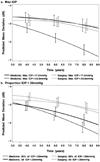Intraocular pressure control and long-term visual field loss in the Collaborative Initial Glaucoma Treatment Study
- PMID: 21600658
- PMCID: PMC3161134
- DOI: 10.1016/j.ophtha.2011.01.047
Intraocular pressure control and long-term visual field loss in the Collaborative Initial Glaucoma Treatment Study
Abstract
Objective: To evaluate the impact of measures of intraocular pressure (IOP) control on progression of visual field (VF) loss during long-term treatment for open-angle glaucoma (OAG).
Design: Longitudinal, randomized clinical trial.
Participants: We included 607 participants with newly diagnosed OAG.
Methods: Study participants were randomly assigned to initial treatment with medications or trabeculectomy, and underwent examination at 6-month intervals. Standardized testing included Goldmann applanation tonometry and Humphrey 24-2 full threshold VFs. Summary measures of IOP control during follow-up included the maximum, mean, standard deviation (SD), range, proportion less than 16, 18, 20, or 22 mmHg, and whether all IOP values were less than each of these 4 cutpoints. Predictive models for VF outcomes were based on the mean deviation (MD) from VF testing, and were adjusted for age, gender, race, baseline VF loss, treatment, and time. Each summary IOP measure was included as a cumulative, time-dependent variable, and its association with subsequent VF loss was assessed from 3 to 9 years postrandomization. Both linear mixed models, to detect shifts in MD levels, and logistic models, to detect elevated odds of substantial worsening (≥3 dB), were used.
Main outcome measures: We measured the MD from Humphrey 24-2 full threshold VF tests.
Results: The effect of the summary IOP measures differed between the medicine and surgery groups in models that addressed the continuous MD outcome. After adjustment for baseline risk factors, in the medicine group larger values of 3 IOP control measures-maximum IOP (P = 0.0003), SD of IOP (P = 0.0056), and range of IOP (P<0.0001)-were significantly associated with lower (worse) MD over the 3- to 9-year period. No IOP summary measure was significantly associated with MD over time in the surgery group. The same 3 IOP summary measures were also significantly associated with substantial worsening of MD; however, the effects were similar in both treatment groups. In models predicting inadequate IOP control, consistently significant predictors of higher maximum, SD, and range of IOP included black race, higher baseline IOP, and clinical center.
Conclusions: These results support considering more aggressive treatment when undue elevation or variation in IOP measures is observed.
Copyright © 2011 American Academy of Ophthalmology. Published by Elsevier Inc. All rights reserved.
Conflict of interest statement
Dr. Musch is a consultant to Glaukos Corporation and AqueSys, Inc. No conflicting relationship exists for Ms. Niziol, Dr. Gillespie, Dr. Lichter, and Dr. Varma.
Figures



References
-
- Gordon MO, Beiser JA, Brandt JD, et al. Ocular Hypertension Treatment Study Group. The Ocular Hypertension Treatment Study: baseline factors that predict the onset of primary open-angle glaucoma. Arch Ophthalmol. 2002;120:714–720. - PubMed
-
- Heijl A, Leske MC, Bengtsson B, et al. Early Manifest Glaucoma Trial Group. Reduction of intraocular pressure and glaucoma progression: results from the Early Manifest Glaucoma Trial. Arch Ophthalmol. 2002;120:1268–1279. - PubMed
-
- Leske MC, Heijl A, Hussein M, et al. Early Manifest Glaucoma Trial Group. Factors for glaucoma progression and the effect of treatment: the Early Manifest Glaucoma Trial. Arch Ophthalmol. 2003;121:48–56. - PubMed
-
- Leske MC, Heijl A, Hyman L, et al. EMGT Group. Predictors of long-term progression in the Early Manifest Glaucoma Trial. Ophthalmology. 2007;114:1965–1972. - PubMed
Publication types
MeSH terms
Substances
Grants and funding
LinkOut - more resources
Full Text Sources
Other Literature Sources
Medical
Miscellaneous

